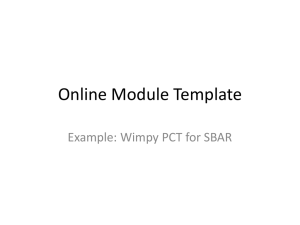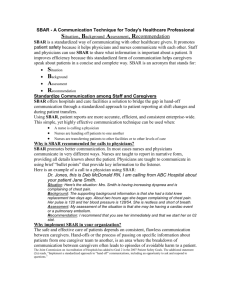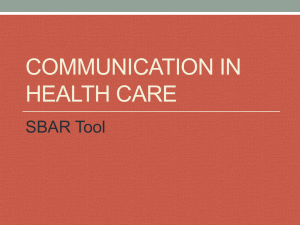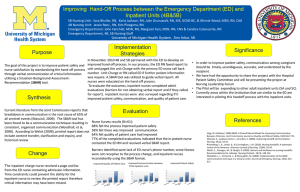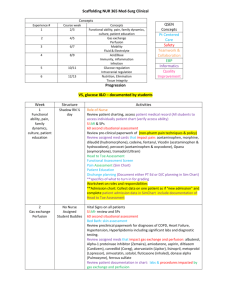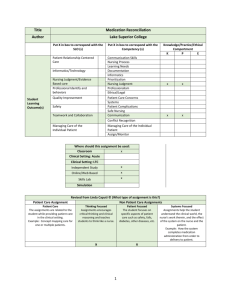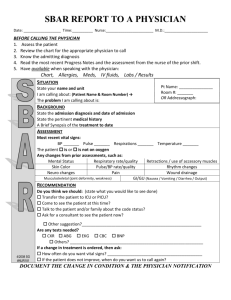SBAR - CHAMP
advertisement
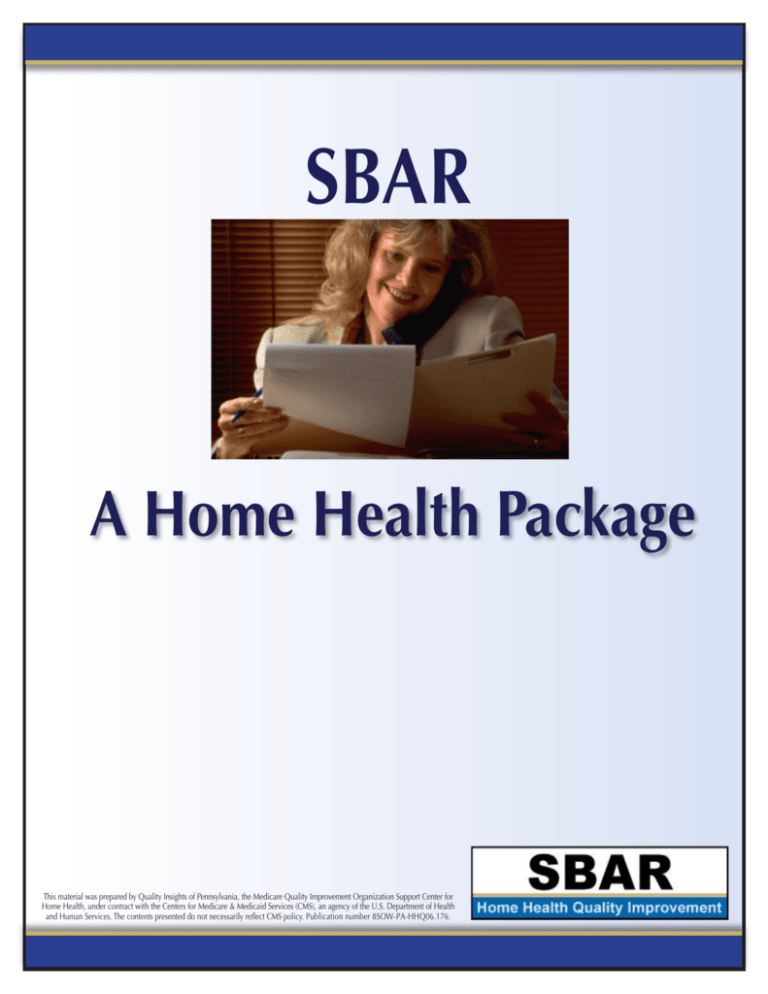
SBAR A Home Health Package This material was prepared by Quality Insights of Pennsylvania, the Medicare Quality Improvement Organization Support Center for Home Health, under contract with the Centers for Medicare & Medicaid Services (CMS), an agency of the U.S. Department of Health and Human Services. The contents presented do not necessarily reflect CMS policy. Publication number 8SOW-PA-HHQ06.176. Home Health Package Introduction SBAR Purpose: The SBAR tool is a strategy to improve communication from clinician to physician, clinician-to-clinician and/or staff to manager. SBAR was adapted from the US Navy Nuclear Submarine Service. Submarine officers and crew needed a situational briefing model to communicate clearly, effectively and efficiently. SBAR organizes the message in a consistent and concise manner. SBAR has been adapted successfully into health care. S = Situation What is going on with the patient? A concise statement of the problem. B = Background What is the clinical background information that is pertinent to the situation? A = Assessment What did you find? Analysis and considerations of options. R = Recommendation What action/recommendation is needed to correct the problem? What do you want? SBAR, the Home Health Connection: SBAR is perfect for improving communications in a home health agency (HHA). This simple tool condenses messages so they contain only concise and significant information about the patient and allows for the clinician to verbalize their assessment of the situation what they think is happening and what recommendations/actions the clinician feels are needed to correct the problem. SBAR can be a strategy used with physicians to improve communications and outcomes, including reducing avoidable acute care hospitalizations. SBAR can also be used between staff and/or management. This tool can help HHAs clearly, effectively and efficiently express the real message of the patient situation. SBAR works well for home health aides to communicate to their supervisors or to the nurse as well as in interdisciplinary communication. Sequencing & Reinforcing SBAR: SBAR is a standardized communication tool that is very easy and simple to use. It is recommended that you start with a small group or office and pilot this method prior to rolling it out to the entire workforce. During the pilot you can make necessary changes without any problems. Once you have successfully implemented it on a small scale you can spread it throughout your organization. SBAR works well in more complex situations such as designing it to meet the specifications of a disease management program (refer to COPD example in package). Always remember to reinforce the new concept to gain behavioral changes and staff buy-in. This package includes several tools/resources to help you. These tools should be modified to your agency’s specifications. SBAR – Home Health Package Contents & Description: • • • • • • • • • SBAR - An Opportunity to Improve Communication within the Home Health Arena Educational Session o A XX minute Webex and audio recording on what SBAR is and how to use SBAR in home health. WebEx or audio can be used as part of staff education on SBAR and for leadership education. SBAR Tool o A simple one page SBAR tool designed for home health. This document is in Microsoft Word and can be modified by your agency to meet your needs. The agency logo or name can also be added. COPD SBAR o This COPD SBAR tool was designed using current standards of practice per the Global Initiative for Chronic Obstructive Lung Disease (GOLD), www.goldcopd.com. SBAR Poster o This poster was designed by Kaiser Permanente to be utilized as a visual reminder for staff throughout the organization. SBAR Interdisciplinary Communication o Sample SBAR sheets for each discipline (nursing, physical therapy, occupational therapy, speech therapy, medical social worker and home health aide). Print the sheets and cut in half to use in your learning sessions. SBAR Pocket Card template o Print these cards on heavier paper and laminate for each staff member when introducing the SBAR concept. Include this pocket card in your orientation process. SBAR Phone Sticker template o Print stickers and place on or near phones as a visual reminder for staff on how to use SBAR. SBAR Discipline worksheets o Exercise worksheets developed for each discipline (nursing, physical therapy, occupational therapy, speech therapy, medical social worker and home health aide) to be used in either small group setting or individually. Print the worksheets and fold back the answer section. SBAR Reference/Resource list o Available resources related to SBAR SBAR – Home Health Package is located on MedQIC at www.medqic.org/hh, Care Transitions, Tools. This educational session covers the following areas related to SBAR: How can an agency transform communication? What is SBAR? Where did SBAR come from? How does SBAR impact health care? Is SBAR only for improving communication to physicians? What SBAR resources are available for home care? This WebEx, audio recording and handouts are located at: www.medqic.org under Care Transitions, Presentations. [Agency Logo] Patient Name: Record #: (Physician Communication) Have ALL information AVAILABLE when reporting: chart, allergies, medication list, pharmacy number, pertinent lab results S B A SITUATION I am calling about: The problem I am calling about is: (patient’s name) BACKGROUND State the primary diagnosis & reason patient is being seen for home care: State the pertinent medical history: Most recent findings: Mental status Neuro changes Temp BP Pulse rate/quality/rhythm Resp rate/quality Lung sounds Pulse Oximetery % Oxygen L/min via GI/GU changes (nausea/vomiting/diarrhea/impaction/hydration) Weight (actual) Loss or Gain Skin color Blood Glucose Wound status (drainage, wound bed, treatment) Pain level/location/status Musculoskeletal changes (weakness) DNR Status Other ASSESSMENT (What do you think is going on with the patient?) I think that the patient is: or I am not sure of what the problem is, but the patient’s status is deteriorating. R RECOMMENDATION I suggest or request: PRN visit or referral: Nurse PT ST OT HH Aide MSW Dietician Visits frequency change Schedule for a physician office visit Physician, Nurse Practitioner or Physician Assistant home visit Pulse Oximetery Lab work Urinalysis, C & S X-rays EKG Medication changes Wound care changes Nutrition or fluid restriction changes Other Call physician with: Staff Name Physician’s Name Date & Time [Agency Logo] Patient Name: Record #: (Physician Communication) Have ALL information AVAILABLE when reporting: chart, allergies, medication list, pharmacy number, pertinent lab results S B SITUATION Identify self <name, title and agency> I am calling about <patient name and location>. The patient's code status is The problem I am calling about is: I am concerned that <patient name> has worsening of their respiratory symptoms. BACKGROUND I have just assessed the patient personally: Vital signs are: Blood pressure _____/_____ Pulse ______ Temperature ______ Respiratory: Respiration rate _____ Pulse oximetry_____ Spirometry ____ FEV1 (indicate pre or post bronchodilator) Peak expiratory flow (PEF)______ (< 100 L/min. indicates a severe exacerbation) Lung sounds: ___ wheezing, ___ rales Edema: ___ LE, ___ abdominal Dyspnea: ___ increased ___ Rate on modified dyspnea scale (0-10, 0 nothing at all to 10 max.) ___Worse at night? Sputum: __ increased amount, ___ thicker/stickier, ___ change in color <note color> Cough: ___ increased Evidence of pleuritic chest pain ___ yes ___ no Accessory muscle retraction: __ yes __ no Altered mental status: ___ sleepiness ___ confusion __ increased anxiety The last hospital admission occurred on <date and time> & the reason for admission was <diagnosis> Respiratory medications include: Short-acting bronchodilator: <name and dose> Long-acting bronchodilator (anticholinergic and/or B2-agonist): <name and dose> Theophylline: <name and dose> Bronochodilator/glucocorticosteroid combination: <name and dose> Systemic glucocorticosteroids: <name and dose> Antibiotic: <name and dose> Today <patient name> took the following medications: <name and dosages> The patient is not or is on oxygen. The patient has been on ________ (l/min) or (%) oxygen for ______ minutes (hours) The oximeter is reading _______% The oximeter does not detect a good pulse and is giving erratic readings. Other comorbidity <name of cormorbid states> and medications for these comorbid conditions include: <name and dosages> The most recent lab results are: <note date and time test was done and results of previous tests for comparison> Staff Name Physician’s Name Date & Time [Agency Logo] A R ASSESSMENT Patient Name: Record #: (What do you think is going on with the patient?) I think that the patient is: I think this patient is having an exacerbation of their COPD due to: Infection Trigger Stress RECOMMENDATION I suggest or request that you: Intensify bronchodilator treatment Add: __ antibiotic and/or __ steroid Adjust O2 rate Transfer the patient to emergency room Reposition patient and continue pursed lip breathing Talk to the patient or family about code status Other Are any tests needed in the home? Do you need any tests like: Spirometry (indicate pre- or post-bronchodilator) __ PEF __ Pulse Oximettry __ ABG __ Others? If a change in treatment is ordered then ask: How often do you want vital signs? How long to you expect this problem will last? If the patient does not get better what medicine should be given and for how long? When would you want us to call again? Staff Name Physician’s Name Date & Time SBAR Interdisciplinary Communication Skilled Nursing SBAR Interdisciplinary Communication Skilled Nursing Use the following SBAR steps to communicate issues, problems or opportunities for improvement to coworkers or supervisors. SBAR can be applied to both written and verbal communications. Use the following SBAR steps to communicate issues, problems or opportunities for improvement to coworkers or supervisors. SBAR can be applied to both written and verbal communications. S S ITUATION – State what is happening at the present time that has warranted the SBAR communication. Example: Hi ITUATION – State what is happening at the present time that has warranted the SBAR communication. Example: Hi Bertha (nursing supervisor) this is Nancy Nurse calling to report that my patient, Lois Lane, has an elevated blood pressure this morning. She also verbalized that she had a nosebleed this a.m. Bertha (nursing supervisor) this is Nancy Nurse calling to report that my patient, Lois Lane, has an elevated blood pressure this morning. She also verbalized that she had a nosebleed this a.m. BACKGROUND – Explain circumstances leading up to this BACKGROUND – Explain circumstances leading up to this situation. Put the situation into context for the reader/listener. situation. Put the situation into context for the reader/listener. Example: Miss Lane’s blood pressure is 188/92 (R) up from 126/80, 186/90 (L). Her pulse has increased from 64 bpm (regular rate and rhythm) to 98 bpm (regular rate and rhythm). Miss Lane reported one nosebleed this a.m. that was stopped when ice was applied to the back of her neck. No other abnormal CPV symptomatology evident during my assessment. The patient has verbalized that she is slightly nervous and jumpy but denies any unusual activity or stress. Example: Miss Lane’s blood pressure is 188/92 (R) up from 126/80, 186/90 (L). Her pulse has increased from 64 bpm (regular rate and rhythm) to 98 bpm (regular rate and rhythm). Miss Lane reported one nosebleed this a.m. that was stopped when ice was applied to the back of her neck. No other abnormal CPV symptomatology evident during my assessment. The patient has verbalized that she is slightly nervous and jumpy but denies any unusual activity or stress. ASSESSMENT – What do you think the problem is? ASSESSMENT – What do you think the problem is? Example: It is difficult to determine what is going on with the patient when the only change in her condition is an elevated blood pressure and what appears to be a panic attack. Example: It is difficult to determine what is going on with the patient when the only change in her condition is an elevated blood pressure and what appears to be a panic attack. RECOMMENDATION – What would you do to correct the RECOMMENDATION – What would you do to correct the problem? Example: I would like you to notify the physician of these findings and ask if we can have a MSW referral for an evaluation. There may be something going on in Miss Lane’s life that she has not recognized as causing the possible anxiety attacks. I would also like you to visit the patient in the a.m. to assess her blood pressure. We will call the physician tomorrow with our findings to see if he would like to schedule Miss Lane for an office visit. problem? Example: I would like you to notify the physician of these findings and ask if we can have a MSW referral for an evaluation. There may be something going on in Miss Lane’s life that she has not recognized as causing the possible anxiety attacks. I would also like you to visit the patient in the a.m. to assess her blood pressure. We will call the physician tomorrow with our findings to see if he would like to schedule Miss Lane for an office visit. SBAR Interdisciplinary Communication Physical Therapy SBAR Interdisciplinary Communication Physical Therapy Use the following SBAR steps to communicate issues, problems or opportunities for improvement to coworkers or supervisors. SBAR can be applied to both written and verbal communications. Use the following SBAR steps to communicate issues, problems or opportunities for improvement to coworkers or supervisors. SBAR can be applied to both written and verbal communications. SITUATION – State what is happening at the present time SITUATION – State what is happening at the present time that has warranted the SBAR communication. Example: Hi that has warranted the SBAR communication. Example: Hi James (rehab manager). This is Phil Thompson, the physical therapist. I am calling about my patient, Mr. Clark Kent, who is complaining of increased pain and redness of the right knee. James (rehab manager). This is Phil Thompson, the physical therapist. I am calling about my patient, Mr. Clark Kent, who is complaining of increased pain and redness of the right knee. B B ACKGROUND – Explain circumstances leading up to this situation. Put the situation into context for the reader/listener. ACKGROUND – Explain circumstances leading up to this situation. Put the situation into context for the reader/listener. Example: Mr. Kent had a right total knee replacement (TKR) 10 days ago. Sutures were removed by nurse 3 days ago and the closed incision is open to air. Caregiver has not cleaned incision as directed by the nurse and therapist. Pain level has increased from a 3 to an 8 over the last 24 hours. Patient is using ice to knee appropriately and taking pain medications as ordered. There is an increased amount of edema in right knee from 1+ to a 2+, and incision is reddened and tender to touch. There is no drainage and no temperature. Pain and edema are interfering with ambulation and exercise program today. Example: Mr. Kent had a right total knee replacement (TKR) 10 days ago. Sutures were removed by nurse 3 days ago and the closed incision is open to air. Caregiver has not cleaned incision as directed by the nurse and therapist. Pain level has increased from a 3 to an 8 over the last 24 hours. Patient is using ice to knee appropriately and taking pain medications as ordered. There is an increased amount of edema in right knee from 1+ to a 2+, and incision is reddened and tender to touch. There is no drainage and no temperature. Pain and edema are interfering with ambulation and exercise program today. ASSESSMENT – What do you think the problem is? ASSESSMENT – What do you think the problem is? Example: Possible infection of surgical incision. Example: Possible infection of surgical incision. RECOMMENDATION – What would you do to correct the RECOMMENDATION – What would you do to correct the problem? Example: PRN skilled nursing visit for wound assessment and to contact physician for wound care orders and teach family wound care. Schedule a follow-up visit with physician. problem? Example: PRN skilled nursing visit for wound assessment and to contact physician for wound care orders and teach family wound care. Schedule a follow-up visit with physician. SBAR Interdisciplinary Communication Occupational Therapy SBAR Interdisciplinary Communication Occupational Therapy Use the following SBAR steps to communicate issues, problems or opportunities for improvement to coworkers or supervisors. SBAR can be applied to both written and verbal communications. Use the following SBAR steps to communicate issues, problems or opportunities for improvement to coworkers or supervisors. SBAR can be applied to both written and verbal communications. SITUATION – State what is happening at the present time SITUATION – State what is happening at the present time that has warranted the SBAR communication. Example: Hi that has warranted the SBAR communication. Example: Hi James (rehab manager). This is Oliver Thorpe, the occupational therapist (OT) calling about my patient, Mrs. Martha Kent, who is refusing a shower bath at this time. James (rehab manager). This is Oliver Thorpe, the occupational therapist (OT) calling about my patient, Mrs. Martha Kent, who is refusing a shower bath at this time. BACKGROUND – Explain circumstances leading up to this BACKGROUND – Explain circumstances leading up to this situation. Put the situation into context for the reader/listener. situation. Put the situation into context for the reader/listener. Example: Mrs. Kent had an ORIF of the left femur from a fall in the home. Pins were removed and patient is now allowed to shower. Patient has refused actual shower and/or handheld shower unit. OT has instructed and performed dry transfers and practiced bathing activities using the tub transfer bench. OT has provided emotional and physical support. Mrs. Kent lives alone, is very anxious and fearful of falling. Ambulating 20 – 25 feet with std. walker and is being followed by physical therapy (PT). Balance in shower is fair to fair +. Patient scored high risk level on falls screening checklist. Education provided on falls prevention. Example: Mrs. Kent had an ORIF of the left femur from a fall in the home. Pins were removed and patient is now allowed to shower. Patient has refused actual shower and/or handheld shower unit. OT has instructed and performed dry transfers and practiced bathing activities using the tub transfer bench. OT has provided emotional and physical support. Mrs. Kent lives alone, is very anxious and fearful of falling. Ambulating 20 – 25 feet with std. walker and is being followed by physical therapy (PT). Balance in shower is fair to fair +. Patient scored high risk level on falls screening checklist. Education provided on falls prevention. ASSESSMENT – What do you think the problem is? ASSESSMENT – What do you think the problem is? Example: Patient is too anxious and afraid of falling at this time, which is creating an unsafe environment. Example: Patient is too anxious and afraid of falling at this time, which is creating an unsafe environment. RECOMMENDATION – What would you do to correct the RECOMMENDATION – What would you do to correct the problem? Example: Supervisor to obtain a home health aide order for 2 – 3 weeks to allow PT to improve strength, balance and confidence. PT to notify OT when patient is steady enough and is willing to begin to work on shower bathing. Skilled nursing/medical social worker to evaluate patient’s anxiety and emotional status. All disciplines to continue teaching falls prevention program to patient and family. problem? Example: Supervisor to obtain a home health aide order for 2 – 3 weeks to allow PT to improve strength, balance and confidence. PT to notify OT when patient is steady enough and is willing to begin to work on shower bathing. Skilled nursing/medical social worker to evaluate patient’s anxiety and emotional status. All disciplines to continue teaching falls prevention program to patient and family. SBAR Interdisciplinary Communication Speech Therapy SBAR Interdisciplinary Communication Speech Therapy Use the following SBAR steps to communicate issues, problems or opportunities for improvement to coworkers or supervisors. SBAR can be applied to both written and verbal communications. Use the following SBAR steps to communicate issues, problems or opportunities for improvement to coworkers or supervisors. SBAR can be applied to both written and verbal communications. SITUATION – State what is happening at the present time SITUATION – State what is happening at the present time that has warranted the SBAR communication. Example: Hi that has warranted the SBAR communication. Example: Hi Ginny (nursing manager). This is Samantha Turner, the speech therapist. I evaluated our patient, Mr. Perry White, today for difficulty swallowing. Ginny (nursing manager). This is Samantha Turner, the speech therapist. I evaluated our patient, Mr. Perry White, today for difficulty swallowing. B B ACKGROUND – Explain circumstances leading up to this situation. Put the situation into context for the reader/listener. ACKGROUND – Explain circumstances leading up to this situation. Put the situation into context for the reader/listener. Example: Mr. White has a hx of CVA and has developed occasional choking on thin liquids. Instructed his wife to have patient in upright position (90 degrees) when feeding him and the use of chin to chest technique for swallowing. Also instructed to add “Thick-it” to the consistency of honey for all thin liquids (water, coffee, juice) and to eat slowly and chew food thoroughly. A patient education sheet on dysphagia and s/s aspiration was left in the patients’ folder in the home. Example: Mr. White has a hx of CVA and has developed occasional choking on thin liquids. Instructed his wife to have patient in upright position (90 degrees) when feeding him and the use of chin to chest technique for swallowing. Also instructed to add “Thick-it” to the consistency of honey for all thin liquids (water, coffee, juice) and to eat slowly and chew food thoroughly. A patient education sheet on dysphagia and s/s aspiration was left in the patients’ folder in the home. ASSESSMENT – What do you think the problem is? ASSESSMENT – What do you think the problem is? Example: Patient’s physical status beginning to decline, losing some muscle tone in throat muscles. Example: Patient’s physical status beginning to decline, losing some muscle tone in throat muscles. R R ECOMMENDATION – What would you do to correct the problem? Example: Skilled nursing (SN) to reinforce ST teaching, ECOMMENDATION – What would you do to correct the problem? Example: Skilled nursing (SN) to reinforce ST teaching, teaching sheet, use of “Thick-it,” and s/s to notify agency or physician. SN to continue to monitor swallowing difficulty and re-consult ST if status starts to decline. ST would obtain order for Barium Swallow if status declines. teaching sheet, use of “Thick-it,” and s/s to notify agency or physician. SN to continue to monitor swallowing difficulty and re-consult ST if status starts to decline. ST would obtain order for Barium Swallow if status declines. SBAR Interdisciplinary Communication Medical Social Worker (MSW) SBAR Interdisciplinary Communication Medical Social Worker (MSW) Use the following SBAR steps to communicate issues, problems or opportunities for improvement to coworkers or supervisors. SBAR can be applied to both written and verbal communications. Use the following SBAR steps to communicate issues, problems or opportunities for improvement to coworkers or supervisors. SBAR can be applied to both written and verbal communications. SITUATION – State what is happening at the present time SITUATION – State what is happening at the present time that has warranted the SBAR communication. Example: Hi that has warranted the SBAR communication. Example: Hi Ginny (nursing manager). This is Melissa Stewart, the medical social worker. I was consulted to see our patient, Mr. James Olsen, related to medication non-compliance with oral medications, diet and possible financial issues. Ginny (nursing manager). This is Melissa Stewart, the medical social worker. I was consulted to see our patient, Mr. James Olsen, related to medication non-compliance with oral medications, diet and possible financial issues. BACKGROUND – Explain circumstances leading up to this BACKGROUND – Explain circumstances leading up to this situation. Put the situation into context for the reader/listener. Example: Mr. Olsen was admitted for diabetes management 2 weeks situation. Put the situation into context for the reader/listener. Example: Mr. Olsen was admitted for diabetes management 2 weeks ago. Patient’s blood sugars remain above 200, even with medication adjustments. Diabetic educator saw patient and will be following up with patient this week. Patient has been only taking his blood sugar pills once a day to try to stretch them out until he gets his check in 2 weeks. ago. Patient’s blood sugars remain above 200, even with medication adjustments. Diabetic educator saw patient and will be following up with patient this week. Patient has been only taking his blood sugar pills once a day to try to stretch them out until he gets his check in 2 weeks. ASSESSMENT – What do you think the problem is? ASSESSMENT – What do you think the problem is? Example: MSW found that he does have financial hardship with oral Example: MSW found that he does have financial hardship with oral medications and with buying sugar-free foods. Mr. Olsen does qualify for additional medical and financial assistance. medications and with buying sugar-free foods. Mr. Olsen does qualify for additional medical and financial assistance. RECOMMENDATION – What would you do to correct the RECOMMENDATION – What would you do to correct the problem? Example: MSW made appropriate referrals to medical problem? Example: MSW made appropriate referrals to medical assistance office related to medications and food. Also referral made to local food bank and community network to help provide him immediate food assistance. MSW contacted the patient’s niece, who will purchase the additional medications needed, until financial assistance is in place. skilled nursing (SN) to follow up with patient’s niece and evaluate his medication regimen for possible consolidation of medications. SN needs to remind the patient to follow through with the medial assistance office. assistance office related to medications and food. Also referral made to local food bank and community network to help provide him immediate food assistance. MSW contacted the patient’s niece, who will purchase the additional medications needed, until financial assistance is in place. skilled nursing (SN) to follow up with patient’s niece and evaluate his medication regimen for possible consolidation of medications. SN needs to remind the patient to follow through with the medial assistance office. SBAR Interdisciplinary Communication Home Health Aide SBAR Interdisciplinary Communication Home Health Aide Use the following SBAR steps to communicate issues, problems or opportunities for improvement to coworkers or supervisors. SBAR can be applied to both written and verbal communications. Use the following SBAR steps to communicate issues, problems or opportunities for improvement to coworkers or supervisors. SBAR can be applied to both written and verbal communications. SITUATION – State what is happening at the present time SITUATION – State what is happening at the present time that has warranted the SBAR communication. Example: Hi Bertha (nursing supervisor). This is Holly, the home health aide, and I am calling to report that my patient, Mr. Lex Luthor, is more short of breath today. that has warranted the SBAR communication. Example: Hi Bertha (nursing supervisor). This is Holly, the home health aide, and I am calling to report that my patient, Mr. Lex Luthor, is more short of breath today. BACKGROUND – Explain circumstances leading up to this BACKGROUND – Explain circumstances leading up to this situation. Put the situation into context for the reader/listener. Example: Mr. Luthor became short of breath when he walked to the bathroom and during his shower. His wife is concerned and said that he has not been watching his salt and is eating what he wants. situation. Put the situation into context for the reader/listener. Example: Mr. Luthor became short of breath when he walked to the bathroom and during his shower. His wife is concerned and said that he has not been watching his salt and is eating what he wants. ASSESSMENT – What do you think the problem is? ASSESSMENT – What do you think the problem is? Example: He is more short of breath, and he is not following his diet. Example: He is more short of breath, and he is not following his diet. RECOMMENDATION – What would you do to correct the RECOMMENDATION – What would you do to correct the problem? Example: Have the nurse make a visit or phone call to Mr. Luthor. problem? Example: Have the nurse make a visit or phone call to Mr. Luthor. SBAR A structured communication technique designed to convey a great deal of information in a succinct and brief manner. This is important as we all have different styles of communicating, varying by profession, culture, and gender. S B A R Situation A concise statement of the problem What is going on now Background Pertinent and brief information related to the situation What has happened Assessment Analysis and considerations of options What you found/think is going on Recommendation Request/recommend action What you want done 2004 Kaiser Foundation Health Plan, Inc. Kaiser Foundation Health Plan, Inc. is the owner and holds the copyright of the material(s) and must be acknowledged in all print and electronic media as the original developer and copyright holder of the material(s). Copy on heavy paper and laminate for staff S – Situation & identify self/agency B – Background A – Assessment R – Recommendation S – Situation & identify self/agency B – Background A – Assessment R – Recommendation S – Situation & identify self/agency B – Background A – Assessment R – Recommendation S – Situation & identify self/agency B – Background A – Assessment R – Recommendation S – Situation & identify self/agency B – Background A – Assessment R – Recommendation S – Situation & identify self/agency B – Background A – Assessment R – Recommendation S – Situation & identify self/agency B – Background A – Assessment R – Recommendation S – Situation & identify self/agency B – Background A – Assessment R – Recommendation S – Situation & identify self/agency B – Background A – Assessment R – Recommendation S – Situation & identify self/agency B – Background A – Assessment R – Recommendation S – Situation & identify self/agency B – Background A – Assessment R – Recommendation S – Situation & identify self/agency B – Background A – Assessment R – Recommendation S – Situation & identify self/agency B – Background A – Assessment R – Recommendation S – Situation & identify self/agency B – Background A – Assessment R – Recommendation S – Situation & identify self/agency B – Background A – Assessment R – Recommendation S – Situation & identify self/agency B – Background A – Assessment R – Recommendation S – Situation & identify self/agency B – Background A – Assessment R – Recommendation S – Situation & identify self/agency B – Background A – Assessment R – Recommendation S – Situation & identify self/agency B – Background A – Assessment R – Recommendation S – Situation & identify self/agency B – Background A – Assessment R – Recommendation S – Situation & identify self/agency B – Background A – Assessment R – Recommendation S – Situation & identify self/agency B – Background A – Assessment R – Recommendation S – Situation & identify self/agency B – Background A – Assessment R – Recommendation S – Situation & identify self/agency B – Background A – Assessment R – Recommendation S – Situation & identify self/agency B – Background A – Assessment R – Recommendation S – Situation & identify self/agency B – Background A – Assessment R – Recommendation S – Situation & identify self/agency B – Background A – Assessment R – Recommendation S – Situation & identify self/agency B – Background A – Assessment R – Recommendation S – Situation & identify self/agency B – Background A – Assessment R – Recommendation S – Situation & identify self/agency B – Background A – Assessment R – Recommendation SBAR Scenario Read the following scenario and then complete the SBAR individually or in a small group. Discuss your SBAR with your partner or your small group. S Nursing Mr. Smith is a 78-year-old patient with CHF and HTN who lives with elderly wife. Today’s vital signs were: T - 98.6, BP - 188/90, RR - 24. He is more SOB today as evidenced by an increased respiration rate and now SOB ambulating 8 feet (baseline ability - ambulate 20 feet). Lung sounds were previously clear, but today he has crackles in the posterior bilateral lower bases (1/3rd lung fields). He usually has +1 edema, but today it is now +2 and slightly pitting. Mr. Smith’s wife forgot to weigh him for the last 3 days, but he has now gained 6 lbs. over 4 days. His current med regime includes: Digoxin, 0.125 mg, every day; Lasix, 20 mg, every day; Slow-K, 20 meq, every day; and Prinivil, 5 mg, every day. He has no standing/prn orders. You talk with his wife about his compliance with his medication regimen and she states her daughter pre-fills the medications once a week. Upon examining the pillbox, it appears that the medications were given as ordered. His diet recall was not much different than his normal 2 gm Na diet, except for a ham dinner 2 days ago. His wife is anxious over his change in status. Nancy Nurse calls Dr. Gannon with the update. Skilled Nursing Worksheet B A R S B A R Dr. Gannon, I am Nancy Nurse from ABC Home Care. I am calling about Mr. James Smith, whose blood pressure, respirations & weight are elevated. Mr. Smith, a 78-year-old patient, with diagnosis of CHF & HTN. BP has increased to 188/90, resp. to 24. SOB when ambulating 8 feet, previously SOB at 20 feet. Wgt increased 6#/4 days. Crackles in the posterior bilateral lower bases (1/3rd lung field). Compliant with medications. For the most part he is compliant with his 2 gm Na diet, with the exception of eating ham for dinner two days ago. Mr. Smith is experiencing fluid retention which may or may not have been exacerbated by the ham dinner. I would like to give Mr. Smith a dose of IV Lasix now and then continue with his daily Lasix p.o. dose in the a.m. I will have his wife measure his urine output for the next 24 hours to assess his diuresis. I would like an order to visit in the a.m. to assess his respiratory status, and urine output. May I draw a stat K+ level? I will call you with the visit results in the a.m. The on-call nurse will call his wife in 2 hours to assess Mr. Smith’s SOB and urine output. Mrs. Smith will be instructed on the s/s to watch for and to call if the patient’s SOB worsens. Skilled Nursing Worksheet Read the sample scenario inside and complete the SBAR. Then, look at the back panel for a possible example. SBAR Scenario Read the following scenario and then complete the SBAR individually or in a small group. Discuss your SBAR with your partner or your small group. S Physical Therapy Mrs. Jones is a 78-year-old female. She lives in a one-story home with her elderly husband, who is also a patient on home care, and she is his primary caregiver. Mrs. Jones’s past medical diagnosis is HTN. She has become increasingly unsteady on her feet within the last several weeks. A referral was made to PT to evaluate lower extremity strengthening and gait training. Phillip Thomas’ (physical therapist) findings include: ambulates 15 – 20 feet using furniture & walls. Both ambulation and standing balance fair (-). Strength BLE 3+/5 & BUE 3+/5. No other gait abnormalities exist. Pt. showers alone and there are no grab bars or any other shower equipment. A fall risk assessment evidences the patient scored as high risk. PT initiates call to Dr. Gannon, the patient’s physician. B A R Physical Therapy Worksheet S B A R Dr. Gannon, I am Phillip Thomas, a physical therapist at ABC Home Care. I am calling about Mrs. Helen Jones who was referred with weakness, and I am identifying as a high risk for falling. Mrs. Jones, a 78-year-old patient, lives at home with her elderly, ill husband. She scored at high risk on our falls risk assessment related to ambulating only with walls and furniture for support short distances; her balance is fair (-). She does not have any safety equipment in the bathroom (no grab bars). Her standing balance is fair. There is no other s/s at this time. Patient has developed some weakness with her legs and she has a balance issue that is putting her at risk for a fall. Patient needs an order for: a standard walker and a medical social worker referral to assess Mrs. Jones declining condition, which may negatively impact her ability to care for her husband. Physical Therapy Worksheet Read the sample scenario inside and complete the SBAR. Then, look at the back panel for a possible example. SBAR Scenario Read the following scenario and then complete the SBAR individually or in a small group. Discuss your SBAR with your partner or your small group. S Occupational Therapy Mr. Wilson is a 69-year-old patient with CVA 5 years ago with right latent hemiplegia. Skilled nursing (SN) was referred to see patient due to an open wound on right thumb from contracture of the right hand. SN initiated appropriate wound care and obtained an order for an OT evaluation. Oliver Thorpe, OT’s findings included: right hand contracture, fist-like, with pressure being applied to mid thumb joint from the index finger. Right wrist drop was also noted. The patient is unable to grip with his right hand. There is good circulation to the hand without other reddened areas at this time. The patient is at high risk for more breakdown. Caregiver denies having a splint or cone for patient. OT wants to fabricate a cock-up splint for the right hand and to see the patient according to the following schedule - 3x/week x 2 weeks; 2x/week x 2 weeks. The OT visits will involve teaching the caregiver a massage and exercise program to prevent skin breakdown. OT has contacted Dr. Gannon, the patient’s physician regarding his plan for the patient. Occupational Therapy Worksheet B A R S B A R Dr. Gannon, I am Oliver Thorpe, the occupational therapist at ABC Home Care. I am calling about Mr. Wilson’s residual right hand contracture and hand drop causing an open wound. Mr. Wilson is your 69-year-old patient with a history of CVA with residual right hemiplegia, right hand contracture and right wrist drop. Open area right middle thumb joint which the nurse initiated wound care. There is good circulation to right hand. Patient does not have a splint or a cone for prevention. Pressure and poor positioning of right wrist caused on open wound on right middle thumb. OT would like to see patient 3x/week x 2 weeks; 2x/week x 2 weeks to fabricate a cock-up splint right hand, teach the caregiver a massage and exercise program to prevent skin breakdown. Occupational Therapy Worksheet Read the sample scenario inside and complete the SBAR. Then, look at the back panel for a possible example. SBAR Scenario Read the following scenario and then complete the SBAR individually or in a small group. Discuss your SBAR with your partner or your small group. S Speech Therapy Mrs. Adams, a 74-year-old who had a CVA 7 weeks ago, has residual mild weakness of right side. She has been on home care services for the past 6 weeks. Services include SN and PT. OT was previously discontinued. She has now developed some swallowing difficulties, especially with solid foods. She complains that it is difficult to get the “food to go down at times,” but has no problem with liquids. Speech therapy findings included: A, A, & oriented x 3. Speech is clear and non-slurred, and facial muscle tone is normal. She has good gag reflex and is able to swallow liquids without choking or difficulty. Mrs. Adams is able to swallow soft foods, i.e. mashed potatoes and applesauce, but is having difficulty with pieces of meat and some raw vegetables. The patient and family were given instructions on proper feeding techniques as well as safety instructions on eating solid foods. Samantha Turner, the speech therapist, has contacted Dr. Gannon with the aforementioned findings. Speech Therapy Worksheet B A R S B A R Dr. Gannon, I am Samantha Turner, a speech therapist from ABC Home Care. I am calling about Mrs. Sarah Adams who is having difficulty swallowing solid foods. Mrs. Adams is your 74-year-old patient who had a CVA 7 weeks ago. She had some residual mild weakness of right side from the CVA. Recently she developed swallowing difficulties with solid foods, such as meats and raw vegetables. No problem with liquids. Muscle tone of face and throat muscles appear intact and WNL. No neuro abnormalities including normal gag reflex. Mrs. Adams’ dysphagia may be obstructive in nature, such as stricture or a partial mechanical obstruction. Requesting a Modified Barium Swallow. Speech Therapy Worksheet Read the sample scenario inside and complete the SBAR. Then, look at the back panel for a possible example. SBAR Scenario Read the following scenario and then complete the SBAR individually or in a small group. Discuss your SBAR with your partner or your small group. S Medical Social Worker Mrs. White is a 72-year-old with CHF, diabetes, HTN and renal insufficiency. Currently she is ordered 10 different medications. The nurse feels the patient is non-compliant with her medications, and there is very little food in the home. MSW Melissa Stewart’s evaluation includes: Patient receives Social Security of XX dollars a month. Her expenses include rent, utilities, etc. plus her approximated medicine co-payments are more than her monthly income. Patient admits that she has to skip medications because she cannot afford to get them refilled. The MSW finds the patient eligible for some of the state and community programs, since her income is below poverty level. The patient is interested in applying for benefits. Appropriate referrals will be made, but it will take time to process them. The MSW calls a case conference with the primary nurse. The MSW also contacts the physician to ask for appropriate paperwork for the state referrals and reviews Mrs. White’s medication list for the purpose of reducing or consolidating any of her medications. The MSW will send the appropriate state paperwork to Dr. Gannon, the physician for his completion. A complete medication list and the SBAR communication will be faxed to Dr. Gannon. Medical Social Worker Worksheet B A R S B A R Dr. Gannon, I am Melissa Stewart, the medical social worker from ABC Home Care. Mrs. White is not taking her medications correctly and is having financial difficulties. She is a 72-year-old with CHF, diabetes, HTN and renal insufficiency. Currently she is ordered 10 different medications. Her Social Security income does not meet her monthly expenses (rent, utilities, medication co-pays, etc.) and there is little food in the home. She does meet the poverty level for some state and community programs, but it will take time to make referrals and be approved. Mrs. White is not taking her medications as ordered related to financial issues. She does qualify for medical assistance and additional community programs to which she is agreeable. Please have the attached referral forms completed by Dr. Gannon as soon as possible, and send to this address (XXX) to initiate referral. Dr. Gannon will need to review her medication list (attached) to see if any medication reduction or reconciliations could occur to assist with financial savings while waiting for referrals to be processed. Medical Social Worker Worksheet Read the sample scenario inside and complete the SBAR. Then, look at the back panel for a possible example. SBAR Scenario Read the following scenario and then complete the SBAR individually or in a small group. Discuss your SBAR with your partner or your small group. S Home Health Aide Helen the home health aide visits Mrs. Elmer twice a week for bathing. When Helen assists Mrs. Elmer to the bathroom today, she notices that the patient became increasingly short of breath. When Helen asks Mrs. Elmer about her increase in her shortness of breath, Mrs. Elmer responded by saying that it started last night. This morning when she weighed herself she noticed that she was 2 lbs heavier. Helen sat Mrs. Elmer on the chair and called Tammy, the patient’s primary nurse to find out what she should do. B A R Home Health Aide Worksheet S B Hi Tammy (nurse) this is Helen Adams the home health aide. I am at Mrs. Elmer’s house and she is experiencing more shortness of breath (SOB) when walking today. When I walked Mrs. Elmer to the bathroom for her bath she had SOB than she didn’t have on Monday (today is Wednesday). Mrs. Elmer also verbalized that she weighs 2 lbs more than yesterday. I also noticed that her ankles are swollen. If I press on the swollen area and remove my finger you can see the indentation. A I think that it is her Congestive Heart Failure (CHF) again. R I think that you need to see Mrs. Elmer. Home Health Aide Worksheet Read the sample scenario inside and complete the SBAR. Then, look at the back panel for a possible example. References Leonard, M., Bonacum, D., Taggart, B. 2006. Using SBAR to Improve Communication Between Caregivers. Institute for Healthcare Improvement. Leonard, M. 2006. The SBAR Technique: Improving Verbal Communication and Teamwork in Clinical Care. PONL Bulletin, 2(1). Leonard, M., Graham, S., Bonacum, D. 2004. The Human Factor: The Critical Importance of Teamwork and Communication in Providing Self Care. Qual Saf Heath Care 2004, 13:i85-i90. BMJ Publishing Group Ltd. and Institute for Healthcare Improvement. Maison, D. 2006. The Interdisciplinary Team Perspective. Effective Communications Are More Important Than Ever, A Physician’s Perspective. Home Healthcare Nurse, 24(3). http://www.homehealthcarenurseonline.com. Nunes, J. 2005. Patient Safety Leadership Fellowship Learnings Help Put Theory into Practice. A Newsletter from the National Patient Safety Foundation. 8(3). http://www.npsf.org. Quality Insights of Pennsylvania. 2006. Organizational Culture – The Path Through the Woods. Sentinel Events Statistics – March 31, 2006. 2006. Joint Commission on Accreditation of Healthcare Organizations. http://www.jointcommission.org/SentinelEvents/Statistics. Whittington, J., Nagamine, J. 2006. SBAR: Application and Critical Success Factors of Implementation. Institute for Healthcare Improvement.

